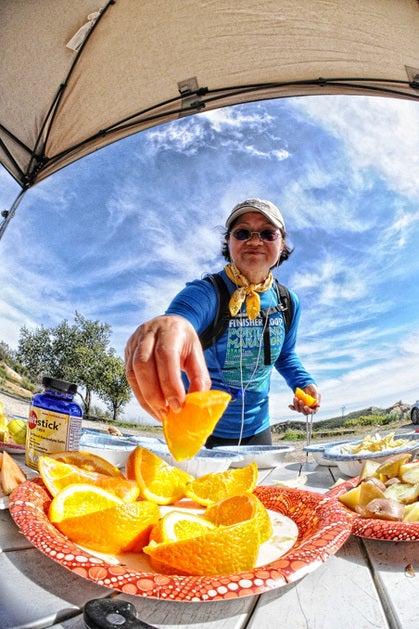Acing Aid Stations

Use them to speed up your next race
Photo by Luis Escobar
For the tired trail runner, aid stations are tempting oases replete with food and drink, a social atmosphere and accommodating volunteers. Many runners get sucked into dawdling, but when used efficiently, aid stations can speed up your race.
Lighten Your Load
“If you’re racing, have a plan,” notes Jason Bryant of Elkin, North Carolina, who was third at the 2011 USATF Trail 50-Mile Championships. Knowing what you will carry from the start and pick up at each aid station is the first step to optimizing your strategy. Heed the mantra “Light Is Right.” Simply, the less weight you carry, the faster and more nimble you will run.
For instance, if you rely on energy gels, you are likely to eat one or two per hour. In longer races, that could mean carrying a hefty pile of gels from the start. However, if you research and find a race’s aid stations provide gels you tolerate, you will not have to carry more than a few at a time, which means less weight and less needed storage capacity. If you do not do your homework, you are likely to err on the side of caution and carry more than you need.
Remember, water/fluids are the heaviest part of your kit. If aid stations are close together or the race is short, you might be able to drink only in the aid stations and not be burdened by carrying water. Planning around aid-station separation, weather conditions and race distance allows you to forego fully filling up for shorter spans.
If aid stations are close together, consider carrying enough water to get you through two aid stations. After all, the quickest aid station is the one you do not use. Top New England trail runner Amy Lane of Westfield, Massachusetts, points out, “At a race like the Vermont 100 with its 29 aid stations, spending just two minutes at every aid station adds nearly an hour onto your time!”
Practice Speedy Exits
Acing an aid station is as much about what you do before arriving as it is about what you do once you are there. Since you know the distance between aid stations (you do, right?), start determining your aid-station needs a mile or so before each. Decide what to pick up (food, drink, other supplies) or get rid of (trash, an extra apparel item).
In ultras, you may need more than just food and drink, and it can be a chore to remember your aid station to-do list. When this happens, come up with a mnemonic device to jog your memory before you arrive at the aid station. I come up with a word for each task and arrange those words into a new funny phrase each time I add a task. Suggests Trail Runner’s Ask the Coach author, Matt Hart, “Repeat your to-do list before you arrive at the aid station, and again when you approach the table.”
Just before arriving at an aid station where you will refill your fluids, open your water bottle(s) or pull the hydration bladder out of your pack. At the aid-station tables, announce to volunteers what you are looking for. Yassine Diboun, an elite runner from Portland, Oregon, advises, “Make eye contact with the volunteer, speak loudly and clearly and be specific about your needs.”
It is generally wise to start your aid-station visit by filling your hydration system before grabbing food or other items. Many times a volunteer will happily fill it for you. In that case, take advantage of the situation by drinking, eating or accomplishing other chores.
Perform only those tasks you determined were necessary before you arrived. It is easy to get tempted by aid stations’ creature comforts, e.g. lounge chairs, heaters and sugary treats. If time is of the essence, say thanks, but no thanks, and keep moving.
Although you will often speed through aid stations, sometimes you need to make the worthwhile time investment to deal with a problem, such as taping a blister, fixing a leaky hydration system or addressing dehydration. Professional trail runner Sean Meissner of Sisters, Oregon, recommends, “If you really need help, don’t hesitate to ask the volunteers. That’s what they’re there for. Most are runners themselves, and are very sympathetic to your needs.”
Whether you are leading the race or just out there having fun, take 2009 Western States 100-mile champion Anita Ortiz’s advice, “Always say `thanks’ to the volunteers!”
AID: Ultra Style
Ultramarathons often allow support crews and drop bags, which are bags you fill with supplies that the race organization distributes on the course, at designated aid stations. Here are some tips for utilizing each.
Support Crews
- Provide your crews with clear instructions and expectations prior to the race.
- Make sure your crew knows how to get to each aid stations.
- Have a Plan B in case your crew does not make it to an aid station.
Drop Bags
- Clearly label each drop bag with your name, your race number and its destination aid station.
- To help the volunteers who schlep your gear into the backcountry, pack only what you need.
- A distinctive-looking drop bag can speed up retrieval at aid stations.